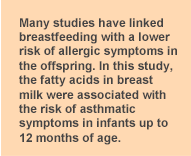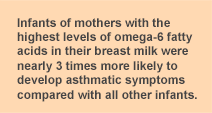
One of the advantages of breastfeeding may be a lower risk that the child will develop symptoms of allergic disease. Studies have reported a lower occurrence of asthma in breastfed Canadian, U.S. and Dutch children, but one study reported a higher risk of asthma and wheeze in breastfed children whose mothers were asthmatic. Children whose mothers ate oily fish during pregnancy were also less likely to develop asthma in some studies, while children whose mothers consumed diets rich in linoleic acid, an omega-6 fatty acid, experienced a higher risk of asthma in later childhood. As breast milk contains many immunological substances and omega-3 fatty acids, which have been associated with less severe allergic symptoms, the question arises whether breast milk fatty acids affect a child's risk of allergic symptoms. Most studies focus on children who are at high risk of allergic diseases because a parent has at least one allergic condition. These children have the greatest need for conditions that might reduce their risk of developing allergic diseases.

This study examined the relationship between the fatty acid composition of breast milk and the risk of allergic disease and asthma in the offspring at 6 and 12 months of age. Participating mothers did not necessarily have a history of allergic disease. Infants were evaluated for symptoms of asthma and sensitivity to a variety of allergens using a skin prick test. Breast milk fatty acids were measured in samples obtained 2 weeks after delivery. The investigators observed that infants whose mothers had the highest levels of omega-6 fatty acids in their breast milk were nearly 3 times more likely to develop asthmatic symptoms compared with all other infants. Breast milk omega-3 fatty acid content was not related to the risk of asthmatic symptoms. These findings were noted at either 6 or 12 months of age.

Results from the skin prick tests showed that 12-month-old infants of mothers with the highest levels of omega-3 fatty acids in their breast milk were the least likely to have a positive skin prick test. Breast milk omega-6 fatty acids were not related to the skin prick test results. These findings suggest that higher levels of omega-6 fatty acids in breast milk, which reflect the fatty acid intake of the mother, may be associated with a greater risk of asthmatic symptoms in the offspring. Omega-3 fatty acid levels showed no protective effects on these symptoms, but were associated with lower sensitivity to other allergens. These findings provide additional evidence that maternal diet, particularly the pattern of polyunsaturated fatty acid intake, may affect the child's risk of developing asthmatic symptoms in the first year of life.
 One of the advantages of breastfeeding may be a lower risk that the child will develop symptoms of allergic disease. Studies have reported a lower occurrence of asthma in breastfed Canadian, U.S. and Dutch children, but one study reported a higher risk of asthma and wheeze in breastfed children whose mothers were asthmatic. Children whose mothers ate oily fish during pregnancy were also less likely to develop asthma in some studies, while children whose mothers consumed diets rich in linoleic acid, an omega-6 fatty acid, experienced a higher risk of asthma in later childhood. As breast milk contains many immunological substances and omega-3 fatty acids, which have been associated with less severe allergic symptoms, the question arises whether breast milk fatty acids affect a child's risk of allergic symptoms. Most studies focus on children who are at high risk of allergic diseases because a parent has at least one allergic condition. These children have the greatest need for conditions that might reduce their risk of developing allergic diseases.
One of the advantages of breastfeeding may be a lower risk that the child will develop symptoms of allergic disease. Studies have reported a lower occurrence of asthma in breastfed Canadian, U.S. and Dutch children, but one study reported a higher risk of asthma and wheeze in breastfed children whose mothers were asthmatic. Children whose mothers ate oily fish during pregnancy were also less likely to develop asthma in some studies, while children whose mothers consumed diets rich in linoleic acid, an omega-6 fatty acid, experienced a higher risk of asthma in later childhood. As breast milk contains many immunological substances and omega-3 fatty acids, which have been associated with less severe allergic symptoms, the question arises whether breast milk fatty acids affect a child's risk of allergic symptoms. Most studies focus on children who are at high risk of allergic diseases because a parent has at least one allergic condition. These children have the greatest need for conditions that might reduce their risk of developing allergic diseases.  This study examined the relationship between the fatty acid composition of breast milk and the risk of allergic disease and asthma in the offspring at 6 and 12 months of age. Participating mothers did not necessarily have a history of allergic disease. Infants were evaluated for symptoms of asthma and sensitivity to a variety of allergens using a skin prick test. Breast milk fatty acids were measured in samples obtained 2 weeks after delivery. The investigators observed that infants whose mothers had the highest levels of omega-6 fatty acids in their breast milk were nearly 3 times more likely to develop asthmatic symptoms compared with all other infants. Breast milk omega-3 fatty acid content was not related to the risk of asthmatic symptoms. These findings were noted at either 6 or 12 months of age.
This study examined the relationship between the fatty acid composition of breast milk and the risk of allergic disease and asthma in the offspring at 6 and 12 months of age. Participating mothers did not necessarily have a history of allergic disease. Infants were evaluated for symptoms of asthma and sensitivity to a variety of allergens using a skin prick test. Breast milk fatty acids were measured in samples obtained 2 weeks after delivery. The investigators observed that infants whose mothers had the highest levels of omega-6 fatty acids in their breast milk were nearly 3 times more likely to develop asthmatic symptoms compared with all other infants. Breast milk omega-3 fatty acid content was not related to the risk of asthmatic symptoms. These findings were noted at either 6 or 12 months of age.  Results from the skin prick tests showed that 12-month-old infants of mothers with the highest levels of omega-3 fatty acids in their breast milk were the least likely to have a positive skin prick test. Breast milk omega-6 fatty acids were not related to the skin prick test results. These findings suggest that higher levels of omega-6 fatty acids in breast milk, which reflect the fatty acid intake of the mother, may be associated with a greater risk of asthmatic symptoms in the offspring. Omega-3 fatty acid levels showed no protective effects on these symptoms, but were associated with lower sensitivity to other allergens. These findings provide additional evidence that maternal diet, particularly the pattern of polyunsaturated fatty acid intake, may affect the child's risk of developing asthmatic symptoms in the first year of life.
Results from the skin prick tests showed that 12-month-old infants of mothers with the highest levels of omega-3 fatty acids in their breast milk were the least likely to have a positive skin prick test. Breast milk omega-6 fatty acids were not related to the skin prick test results. These findings suggest that higher levels of omega-6 fatty acids in breast milk, which reflect the fatty acid intake of the mother, may be associated with a greater risk of asthmatic symptoms in the offspring. Omega-3 fatty acid levels showed no protective effects on these symptoms, but were associated with lower sensitivity to other allergens. These findings provide additional evidence that maternal diet, particularly the pattern of polyunsaturated fatty acid intake, may affect the child's risk of developing asthmatic symptoms in the first year of life.

